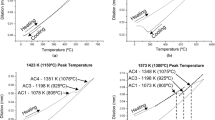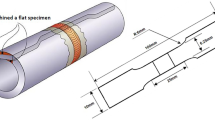Abstract
An experimental gas-metal arc (GMA) weldment of HSLA-100 steel fabricated with an ultralowcarbon (ULC) consumable of interest for United States Navy applications, designated “ARC100,” was studied to determine the relationships among the microstructure, the solute redistributions at various positions across the weldment, and the local properties (microhardness). These relationships were investigated by a variety of techniques, including microhardness mapping, optical microscopy, transmission electron microscopy (TEM), scanning electron microscopy (SEM), energy-dispersive spectroscopy (EDS) (including compositional X-ray mapping), and parallel electron energy-loss spectroscopy (PEELS). The microconstituents observed in this weld include lath ferrite, degenerate ferrite, lath martensite, retained austenite, and oxide inclusions; no carbides or other solid-state precipitates are present within the weld metal. Microhardness mapping indicates an undermatched weld metal (lower hardness as compared to the base plate) in which the hardest regions are in the first and last top beads, the root passes, and between highly ferritic soft bands associated with the outer portion of each weld bead’s heat-affected zone (HAZ) (within the fusion zone). The majority of the gradient in the substitutional alloying elements (Ni, Cu, Mn, and Cr) occurs within a region of less than about 0.5 mm of the fusion boundary, but the composition still changes even well into the fusion zone. Appreciable segregation of Ni and Cu to solidification cell boundaries occurs, and there is appreciable enrichment of C, Ni, Cu, and Mn in thin films of interlath retained austenite. This ULC weld metal is softer than the base plate due to the preponderance of lath ferrite rather than lath martensite, even at the high cooling rates experienced in this low-heat-input weld. Alternatively, the strength of the weld metal is due to the presence of at least some untempered lath martensite and the fact that the majority of the ferrite is lath ferrite and not polygonal ferrite. The interlath retained austenite might enhance toughness, but might also serve as a source of hydrogen in solution, which could potentially contribute to hydrogen-assisted cracking.
Similar content being viewed by others
References
J.J. Deloach, Jr.: in Welding and Weld Automation in Shipbuilding, R. Dinale, ed., TMS, Warrendale, PA, 1996, pp. 85–104.
E.J. Czyryca, R.E. Link, R.J. Wong, D.A. Aylor, T.W. Montemarano, and J.P. Gudas: Nav. Eng. J., 1990, vol. 102 (3), pp. 63–81.
G. Spanos, D.W. Moon, R.W. Fonda, E.S.K. Menon, and A.G. Fox: Proc. 5th Int. Conf. on Trends in Welding Research, ASM INTERNATIONAL, Metals Park, OH, 1999, pp. 191–96.
A.W. Brewer, K.A. Erven, and G. Krauss: Mater. Characterization, 1991, vol. 27, pp. 53–56.
“Standard Test Method for Microhardness of Materials,” ASTM Designation: E384–84, Annual Book of ASTM Standards, ASTM, Philadelphia, PA, 1989, vol. 03.01, pp. 469–83.
R.W. Fonda, G. Spanos, and R.A. Vandermeer: Proc. 4th Int. Conf. Trends in Welding Research, ASM INTERNATIONAL, Metals Park, OH, 1996, pp. 277–82.
D.W. Moon, R.W. Fonda, and G. Spanos: Welding J. Res. Suppl., 2000, vol. 79 (10), pp. 278s-285s.
J.C. Ion, K.E. Easterling, and M.F. Ashby: Acta Metall., 1984, vol. 32, pp. 1949–62.
R.W. Fonda, G. Spanos, and R.A. Vandermeer: Scripta Metall., 1994, vol. 31, pp. 683–88.
H. Homa, S. Ohita, S. Matsuda, and K. Yamamoto: Welding J. Res. Suppl., 1987, Oct., pp. 301s–309s.
P.G. Boswell, K.R. Kinsman, G.J. Shiflet, and H.I. Aaronson: Mechanical Properties and Phase Transformations in Engineering Materials, S.D. Antolovich, R.O. Richie, and W.W. Berberich, eds., TMS-AIME, Warrendale, PA, 1986, pp. 445–66.
H.T. Tsubikino and H.I. Aaronson: Metall. Trans. A, 1987, vol. 18A, pp. 2047–60.
P.L. Harrison, M.N. Watson, and R.A. Farrar: Welding Metal Fabrication, 1981, Apr., pp. 161–69.
R.W. Fonda and G. Spanos: Metall. Mater. Trans. A, 2000, vol. 31A, pp. 2145–54.
R.W. Fonda and G. Spanos: Metall. Mater. Trans. A, 2000, in press.
D.J. Abson and R.E. Dolby: Weld. Inst. Res. Bull., 1980, vol. 21 (4), pp. 100–03; IIW Doc. No. IXJ-29-80.
G. Spanos, R.W. Fonda, R.A. Vandermeer, and A. Matuszeski: Metall. Mater. Trans. A, 1995, vol. 26A, pp. 3277–93.
Author information
Authors and Affiliations
Rights and permissions
About this article
Cite this article
Spanos, G., Moon, D.W., Fonda, R.W. et al. Microstructural, compositional, and microhardness variations across a gas-metal arc weldment made with an ultralow-carbon consumable. Metall Mater Trans A 32, 3043–3054 (2001). https://doi.org/10.1007/s11661-001-0179-6
Received:
Issue Date:
DOI: https://doi.org/10.1007/s11661-001-0179-6




